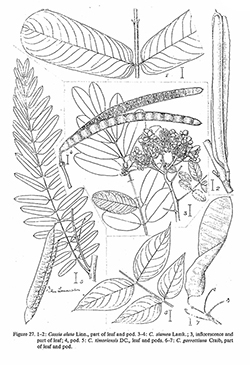e-Flora of Thailand
Volume 4 > Part 1 > Year 1984 > Page 111 > Leguminosae-Caesalpinioideae > Cassia
9. Cassia timoriensis DC.wfo-0000164962
Prod. 2: 499. 1825; Baker in Hook.f., Fl. Br. Ind. 2: 265. 18.78; Gagnep. In Fl. Gén. I.-C. 2: 164–1913; Ridl., Fl. Malay Penins. 1: 617. 1922; Craib in Fl. Siam. En. 1: 514. 1928; de Wit, Webbia 11: 273. 1955; incl. var. xanthacoma Miq., Ann. Ind. 1: 10. 1850; forma xanthocoma (Miq.) de Wit, l.c.; K.Larsen & S.S.Larsenin, Fl. C.L.V. 18: 88. 1980. Fig. 27: 5.
Accepted Name : Senna timoriensis (DC.) H.S.Irwin & Barneby
Mem. New York Bot. Gard. 13: 1964.
Synonyms & Citations :
Description : Small tree up to 10 m high; young branches and leaves varying in indumentum from nearly glabrous to yellowish and golden hairy. Leaves with 10–20 pairs of leaflets. Petioles 1–2 cm ;rhachis 20–30 cm, pubescent. Stipules large, auriculate, 1.5–2.0, cm long. Leaflets with short ยetiolule, oblong, 2–6 by 1–1.5 cm with rounded base and subacute to mucronate apex, from nearly glabrous to yellowish pubescent on both sides. Inflorescences axillary, dense racemes, 10–30 cm long; axis ± glabrous to yellowish, pubescent. Bracts caduceus, ovate, acute up to 20 by 15 mm. Pedicels 1–3 cm, pubescent. Sepals unequal, oblong-ovate with rounded apex, 7–15 mm long, yellowish pubescent outside. Petals yellow, obovate, short-clawcd, 15–20 by 10–15 mm. Stamens 10, 2 largest with filaments 2–4 mm long, anthers 8–10 mm long opening by apical pores; 5 somewhat smaller opening the same way; reduced stamens 3, ca 2 mm. Ovary ± glabrous; style glabrous; stigma inconspicuous. Pods flat glabrous, dehiscent, 8–16 by 1–1.5 cm. Seeds 10–30, elliptic, glossy, flattened, 7 by 5 mm.
Thailand : All over the country.
Distribution : From Ceylon, throughout SE Asia to N Australia. Type from Timer.
Ecology : Seems to prefer limestone areas. It is a small tree always found in open forests (high light requirements) and therefore a common member of the deciduous dipterocarp forests in monsoon Asia. It is often seen as a pioneer species.
Vernacular : Khilek daeng (ขี้เหล็กแดง), khi lek khan Chang (ขี้เหล็กคันชั่ง), khi lek phan Chang (ขี้เหล็กพันชั่ง)(Northern); khi lek luat (ขี้เหล็กสีเลือด)(Central, Northeastern); khi lekdong (ขี้เหล็กดง)(Northeastern); khi lek pa (ขี้เหล็กป่า)(Southeastern, Peninsular); khi lek nang chi (ขี้เหล็กนางชี), cha khi lek (ช้าขี้เหล็ก), kalaeng ngaen (กะแลงแงน)(Peninsular); chi-li-loi (จี้ลี้ลอย)(Shan-Northern); mae-khi-le-thi (แมะขี้เหละที), mae-khae-lae (แมะแค่ะแหล่ะ)(Karen-Northern); pi-ta-kha (ปี้ตะขะ)(Lawa-Northern); ma klua luat (มะเกลือเลือด)(Southwestern).
Notes: There has been some discussion, most recently, by de Wit, as to whether the densely golden hairy form, which seems to be the most common in Thailand, requires taxonomic recoguition [as e.g. forma xantlzocoma (Miq.) de Wit]. As clinal variation from nearly glabrous to densely hairy can be found it does not seem reasonable to maintain a separate name.


